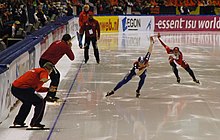Skating step

The skating step is a type of locomotion using special shoes or attachment of special devices to the shoes, which cause sliding or rolling in the longitudinal direction of the foot on a special surface, but allow an impression perpendicular to this direction. In principle, sliding or rolling is possible in both directions - forwards and backwards. The locomotion is now achieved in that each step accompanied by a sliding or rolling process has both a component in the desired direction of movement and an alternating side component between the two legs. As a result, with each alternate step, in addition to moving in the direction of the other leg, you can also move in the desired direction. The anatomically determined components of each step that deviate from the actual direction of movement are opposed and thus generally cancel each other out over the entire distance.
At low speed, the shear angle is quite large - i.e. the angle at which the feet are exposed relative to the direction of travel. In addition, at low speed during the starting phase, only a comparatively short distance is covered with each step, so that quite a number of steps are necessary to gain speed. At maximum speed, the shear angle is small and the distance covered during a single step is large.
In addition to the eponymous ice skating, the ice skating step is also used, for example, in inline skating , roller skating or in the skating technique of cross-country skiing .
Web links
- Franco Normani: The Physics Of Ice Skating.
- Stephan Babiel: Field study on biomechanical influencing variables in selected cross-country skiing techniques. Bochum 2002